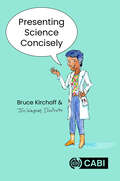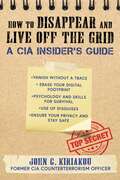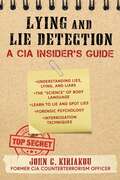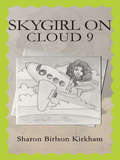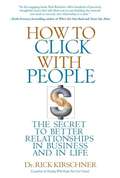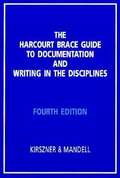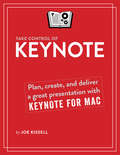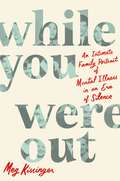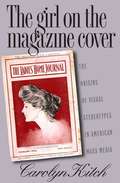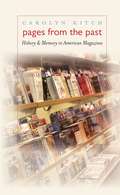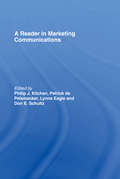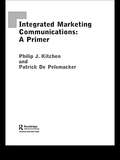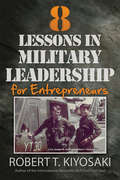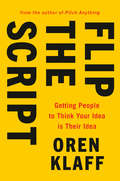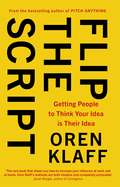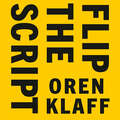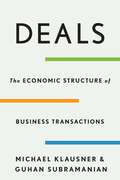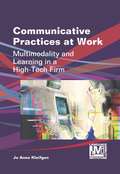- Table View
- List View
Presenting Science Concisely
by Dr Bruce KirchoffImagine you are a scientist faced with presenting your research clearly and concisely. Where would you go for help? This book provides the answer. It shows how to use story structure to craft clear, credible presentations. In it you will find exercises to help you give both short and long presentations. Elevator pitches, lightning talks, Three Minute Thesis (3MT®), and conference presentations are all covered as are suggestions for longer presentations. Separate chapters address good poster design, how to tailor your talk to an audience, and presentation skills. Throughout the book the focus is on creating surprising, memorable stories. Scientific presentations are true stories about new discoveries. They are surprising because every new discovery changes our understanding of the world, and memorable because they move audiences. The book also covers: · Randy Olson's And-But-Therefore (ABT) narrative form · Mike Morrison's Better Poster designs · Eye-tracking analyses of posters by EyeQuant · Numerous case studies and examples from different scientific fields · Links to videos of exemplary presentations With light-hearted illustrations by Jon Wagner this book will appeal to researchers and graduate students in all areas of science, and other disciplines too.
Unternehmenskommunikation im Zeitalter der digitalen Transformation: Wie Unternehmen interne und externe Stakeholder heute und in Zukunft erreichen
by Bodo Kirf Kai-Nils Eicke Souren SchömburgDieses Buch erklärt, wie die Digitalisierung sämtliche Strukturen und Prozesse im Kommunikationsmanagement von Unternehmen verändert und wie Strategien, Konzepte, Aufgabenverteilung und Instrumenteneinsatz angepasst werden müssen, um alle Stakeholder punktgenau zu erreichen. Die Autoren zeigen – wissenschaftlich fundiert und gleichzeitig für die Praxis aufbereitet –, was bei der Transformation einer Kommunikationsorganisation beachtet werden muss, damit interne und externe Stakeholder die richtigen Botschaften über die passenden Kanäle erhalten. Ein kompaktes Buch, das den Lesern in Zeiten von zunehmender Vernetzung wertvolle Orientierung bietet und direkt im Arbeitsalltag anwendbar ist.Neu in der aktualisierten 2. Auflage: Für Leser kostenlose, zusätzliche Fragen und Antworten zum Buch in der Springer-Nature-Flashcards-App.
How to Disappear and Live Off the Grid: A CIA Insider's Guide
by John KiriakouWith an experienced CIA officer as your teacher, you&’ll gain the knowledge and necessary tools to protect yourself and the ones you love.No matter where we go, we leave tracks and clues of our existence without even knowing. Our electronic footprint becomes our invisible trail. In this day in age where the world seems to be at our fingertips and social media plays a huge role in our daily lives, it&’s hard not to leave part of our digital selves for others to find.Whether you&’re fascinated by the idea of disappearing, want to erase your digital footprint, or simply concerned about your safety and privacy, knowing how to become invisible is a survival skill that will come in handy.Through the easy-to-follow instructions, tips, tricks, and professional anecdotes in How to Disappear and Live off the Grid: A CIA Insider's Guide, you&’ll learn to vanish without a trace from John Kiriakou, a former CIA counterterrorism officer and senior investigator for the Senate Foreign Relations Committee responsible for the capture of Abu Zubaydah.
Lying and Lie Detection: A CIA Insider's Guide
by John KiriakouA foolproof guide both to lying and to detecting deception,Lying and Lie Detection: A CIA Insider's Guide will teach you how the pros can tell if and when somebody is lying. People lie all the time. Studies show that the average American lies between six and twenty times a day. Most lies are of the &“little white&” variety or are meant to spare a person&’s feelings. But what about the big lies? What about the consequential ones? You have a right to know when somebody is lying to you. Now, imagine if you had the tools to spot a lie from the truth—a guide to perfect your sixth sense. Whether it's finding out if you truly got the job, unmasking an infidelity, or a simple recommendation, you will no longer have to spend hours, days, or even weeks pondering about it. Through the easy-to-follow instructions and professional anecdotes in Lying and Lie Detection: A CIA Insider's Guide, you&’ll learn to lie and spot lies from John Kiriakou, a former CIA counterterrorism officer and senior investigator for the Senate Foreign Relations Committee responsible for the capture of Abu Zubaydah.Remember, CIA operations officers are trained to lie. They lie all the time. When they are working undercover, they are actually living a lie. With the CIA as a teacher, you&’ll learn how to tell.
“Skygirl On Cloud 9”
by Sharon Birlson Kirkham"Skygirl On Cloud 9" is an entertaining narrative of the amazing globe-trekking adventures of fllight attendant Sharon Birlson Kirkham. Each amusing account recalls one of the exciting opportunities Sharon and her husband Cary have experienced through-out her career, and since. While she says they've done their best to see as much as possible, "the world is a really big place. There are hundreds more trips to be taken and stories to be written, 'but' there are only 365 days in a year...."
English as a Lingua Franca in ASEAN
by Andy KirkpatrickThe lingua franca role of English, coupled with its status as the official langu
How to Click with People
by Rick KirschnerThe Secret to Building Better Relationships in Business and in Life With some people, you just click. The connection is quick and easy. Communication flows. You can tell them anything and they know just what you mean. When you connect in this way, you feel understood and accepted for who you really are. You "get" these people and they get you. We think of this connection as an instantaneous thing, something that either happens or doesn't. Not so, says author Dr. Rick Kirschner. This connection isn't a magical phenomenon; it's a communication skill that can be learned with specific steps and techniques. Based on the author's three decades of experience as an interpersonal communication expert, How to Click with People will show you how to: -Recognize and respond effectively to the four basic communication styles everyone uses-Speak the same language as the person you're talking to, whether emotional or intellectual-Connect in a digital age ruled by e-mail and social media-Master the 7 Signals that will make you-and your ideas-click with others-Troubleshoot the nine obstacles that could be in your way and learn how to avoid or overcome themIn the end, Kirschner argues that these skills are crucial because success has less to do with professional knowledge than with "the ability to express ideas, to assume leadership, and to arouse enthusiasm among people." In this How to Win Friends and Influence People for the twenty-first century, he gives readers the advice and insights they need to strengthen their relationships and take charge of their future. people in your life. If you want to build better relationships, I recommend it."--Mark Sanborn, bestselling author of The Fred Factor"Wise people know that the future is all about people, and Rick Kirschner's new book How to Click with People is a must-read for anyone who wants to understand and use the transformative power of relationships both in business and in life."--Daniel Burrus, author of the New York Times bestseller Flash Foresight"In today's crazy-busy business environment, building strong relationships with frazzled customers and co-workers is essential to your success. Kirschner shows you practical strategies to quickly 'click' with even the most challenging individuals."--Jill Konrath, author of SNAP Selling and Selling to Big Companies
The Harcourt Brace Guide to Documentation and Writing in the Disciplines (4th edition)
by Laurie G. Kirszner Stephen R. MandellPreparing to write for research; developing an argument; writing in the humanities, social sciences, natural sciences, and business; overview of documentation styles for books and articles
Take Control of Keynote
by Joe KissellGive better presentations with this handy guide covering Keynote for the Mac!Need to give a presentation, but worried about how you'll do? Steve Jobs relied on Keynote for his famous keynote presentations, and while using Keynote won't guarantee Jobs-level success, Joe Kissell's advice in Take Control of Keynote will get you closer.Drawing on years of speaking experience, Joe suggests you start by figuring out what you want to say -- and he explains exactly how to accomplish this task, even though you won't do it in Keynote. He then helps you work in Keynote with the right theme, and explains how to create slides by filling in placeholders, adding objects (images, movies, sounds, tables, and charts), and inserting and styling text. You'll also learn how to add build effects to slides and transitions between slides, as well as how to make self-playing presentations designed for kiosks, and presentations with recorded narration or a soundtrack.Finally, Joe offers real-world advice about delivering presentations, including tips on what to bring, making presenter notes and customizing the presenter display, setting up your display, and controlling your presentation."As someone whose life (and income) is doing training presentations, this ebook is the most useful I have ever bought. I know Keynote well and have used it since its first release; however, Joe's ebook has both challenged me to think about the way I structure my presentations and has taught me stuff about Keynote I didn't know." -Michael Durrant, Psychologist ... mental health & corporate trainer (Sydney, Australia)You'll learn how to use the features that go into making a great slide deck:Making master slides with carefully positioned placeholdersAdjusting the slide orderViewing more than one slide at onceUsing all the fancy layout features to position objects on a slideApplying cool visual effects to photos, such as masking and Instant AlphaSorting out builds gone wild with the Build Order paletteHiding particular slides from an audience without deleting themTaking control of text boxes and Keynote's many text styling optionsCreating a presentation that requires clicks in specific places to advanceCommenting on slides while collaborating on your presentationAdditional advice helps you prep for a successful delivery and avoid technical glitches:What to consider in advance, with respect to the screen(s) you'll be usingPracticing the mechanics of delivering from KeynoteViewing presenter notes while you speakPlaying a sound or movie from a slide during your presentationEvaluating the many options for remote control instead of a mouse or trackpadPacking your bag with the right set of cables and gadgetsSetting up once you're at the speaking venueYou'll find even more assistance with answers to questions like:Should I store my presentation on iCloud Drive?What are my options if I want to print my presentation?What's the best way to turn my slide deck into a PDF?The bulk of the book documents Keynote for the Mac, but an appendix explains what's similar and different about Keynote for iOS and Keynote for iCloud.
From Utterances to Speech Acts
by Mikhail KissineMost of the time our utterances are automatically interpreted as speech acts: as assertions, conjectures and testimonies; as orders, requests and pleas; as threats, offers and promises. Surprisingly, the cognitive correlates of this essential component of human communication have received little attention. This book fills the gap by providing a model of the psychological processes involved in interpreting and understanding speech acts. The theory is framed in naturalistic terms and is supported by data on language development and on autism spectrum disorders. Mikhail Kissine does not presuppose any specific background and addresses a crucial pragmatic phenomenon from an interdisciplinary perspective. This is a valuable resource for academic researchers and graduate and undergraduate students in pragmatics, semantics, cognitive linguistics, psycholinguistics and philosophy of language.
While You Were Out: An Intimate Family Portrait of Mental Illness in an Era of Silence
by Meg KissingerFrom award-winning journalist Meg Kissinger, a searing memoir of a family besieged by mental illness, as well as an incisive exploration of the systems that failed them and a testament to the love that sustained them.Growing up in the 1960s in the suburbs of Chicago, Meg Kissinger’s family seemed to live a charmed life. With eight kids and two loving parents, the Kissingers radiated a warm, boisterous energy. Whether they were spending summer days on the shores of Lake Michigan, barreling down the ski slopes, or navigating the trials of their Catholic school, the Kissingers always knew how to live large and play hard.But behind closed doors, a harsher reality was unfolding—a heavily medicated mother hospitalized for anxiety and depression, a manic father prone to violence, and children in the throes of bipolar disorder and depression, two of whom would take their own lives. Through it all, the Kissingers faced the world with their signature dark humor and the unspoken family rule: never talk about it.While You Were Out begins as the personal story of one family’s struggles then opens outward, as Kissinger details how childhood tragedy catalyzed a journalism career focused on exposing our country’s flawed mental health care. Combining the intimacy of memoir with the rigor of investigative reporting, the book explores the consequences of shame, the havoc of botched public policy, and the hope offered by new treatment strategies. Powerful, candid and filled with surprising humor, this is the story of one family’s love and resilience in face of great loss.
Optical Code Division Multiple Access
by Ken-Ichi KitayamaA comprehensive guide to optical fiber communications, from the basic principles to the latest developments in OCDMA for Next-Generation Fiber-to-the-Home (FTTH) systems. Part I starts off with the fundamentals of light propagation in optical fibers, including multiple access protocols, and their enabling techniques. Part II is dedicated to the practical perspectives of Next-Generation Fiber-to-the-Home (FTTH) technology. It covers the key building blocks of OCDMA, devices such as optical encoders and decoders, signal impairments due to noise, and data confidentiality, a unique property of OCDMA. This is followed by hybrid system architectures with TDM and WDM and practical aspects such as system cost, energy efficiency and long-reach PONs. Featuring the latest research, with cutting-edge coverage of system design, optical implementations, and experimental demonstrations in test beds, this text is ideal for students, researchers and practitioners in the industry seeking to obtain an up-to-date understanding of optical communication networks.
The Girl on the Magazine Cover: The Origins of Visual Stereotypes in American Mass Media
by Carolyn KitchFrom the Gibson Girl to the flapper, from the vamp to the New Woman, Carolyn Kitch traces mass media images of women to their historical roots on magazine covers, unveiling the origins of gender stereotypes in early-twentieth-century American culture.Kitch examines the years from 1895 to 1930 as a time when the first wave of feminism intersected with the rise of new technologies and media for the reproduction and dissemination of visual images. Access to suffrage, higher education, the professions, and contraception broadened women's opportunities, but the images found on magazine covers emphasized the role of women as consumers: suffrage was reduced to spending, sexuality to sexiness, and a collective women's movement to individual choices of personal style. In the 1920s, Kitch argues, the political prominence of the New Woman dissipated, but her visual image pervaded print media. With seventy-five photographs of cover art by the era's most popular illustrators, The Girl on the Magazine Cover shows how these images created a visual vocabulary for understanding femininity and masculinity, as well as class status. Through this iconic process, magazines helped set cultural norms for women, for men, and for what it meant to be an American, Kitch contends.
Pages from the Past
by Carolyn KitchAmerican popular magazines play a role in our culture similar to that of public historians, Carolyn Kitch contends. Drawing on evidence from the pages of more than sixty magazines, including Newsweek, Rolling Stone, Black Enterprise, Ladies' Home Journal, and Reader's Digest, Kitch examines the role of journalism in creating collective memory and identity for Americans. Editorial perspectives, visual and narrative content, and the tangibility and keepsake qualities of magazines make them key repositories of American memory, Kitch argues. She discusses anniversary celebrations that assess the passage of time; the role of race in counter-memory; the lasting meaning of celebrities who are mourned in the media; cyclical representations of generational identity, from the Greatest Generation to Generation X; and anticipated memory in commemoration after crisis events such as those of September 11, 2001. Bringing a critically neglected form of journalism to the forefront, Kitch demonstrates that magazines play a special role in creating narratives of the past that reflect and inform who we are now.
Journalism in a Culture of Grief
by Carolyn Kitch Janice HumeThis book considers the cultural meanings of death in American journalism and the role of journalism in interpretations and enactments of public grief, which has returned to an almost Victorian level. A number of researchers have begun to address this growing collective preoccupation with death in modern life; few scholars, however, have studied the central forum for the conveyance and construction of public grief today: news media. News reports about death have a powerful impact and cultural authority because they bring emotional immediacy to matters of fact, telling stories of real people who die in real circumstances and real people who mourn them. Moreover, through news media, a broader audience mourns along with the central characters in those stories, and, in turn, news media cover the extended rituals. Journalism in a Culture of Grief examines this process through a range of types of death and types of news media. It discusses the reporting of horrific events such as September 11 and Hurricane Katrina; it considers the cultural role of obituaries and the instructive work of coverage of teens killed due to their own risky behaviors; and it assesses the role of news media in conducting national, patriotic memorial rituals.
A Reader in Marketing Communications
by Philip J. KitchenCombining seminal papers on marketing communications with incisive commentary and overviews from the editors, case studies and student question and answer sections, this text provides a uniquely global perspective on this topical subject. It can be used as a supplement to textbooks on marketing communications, or as an excellent stand-alone text to give greater instruction and insight into key elements of the twenty-first century promotional mix. Providing a one-stop reference for all those studying marketing communications, this reader tackles the subject from an international perspective. Each chapter is introduced by one of the four editors, each editor being from a different core geographic area – the USA, the Pacific Rim, mainland Europe, and the UK. At the end of each paper questions are posed to test the student readers. Academically rigorous, this essential book contributed to by recognized experts will be a valuable reference for undergraduates and graduates of marketing, communications, business and management.
A Primer for Integrated Marketing Communications
by Philip Kitchen Patrick De PelsmackerThis textbook is the first introductory primer on integrated marketing communications. It combines theory and practice to show students of marketing how different aspects of integrated marketing communications (IMC) work together. Setting the scene in which IMC has emerged, the authors explain each component of the promotional mix and go on to explain the process of functional integration. The text includes key case studies on companies, including Proctor and Gamble, NSPCC and Ardi, illustrating the practical side of IMC in addition to an introduction to the main theories at work. Including an additional Study Guide at the back, this book will be a valuable resource for students of marketing and marketing communications.
Forging Romantic China
by Peter J. KitsonThe first major cultural study to focus exclusively on this decisive period in modern British-Chinese relations. Based on extensive archival investigations, Peter J. Kitson shows how British knowledge of China was constructed from the writings and translations of a diverse range of missionaries, diplomats, travellers, traders, and literary men and women during the Romantic period. The new perceptions of China that it gave rise to were mediated via a dynamic print culture to a diverse range of poets, novelists, essayists, dramatists and reviewers, including Jane Austen, Thomas Percy, William Jones, S. T. Coleridge, George Colman, Robert Southey, Charles Lamb, William and Dorothy Wordsworth and others, informing new British understandings and imaginings of China on the eve of the Opium War of 1839–42. Kitson aims to restore China to its true global presence in our understandings of the culture and literature of Britain in the late eighteenth and early nineteenth centuries.
8 Lessons in Military Leadership for Entrepreneurs
by Robert T. KiyosakiRobert Kiyosaki's new book 8 Lessons in Leadership draws from his years at the Merchant Marine Academy at Kings Point and his service in the United Sates Marine Corps. With compelling stories and examples and a engaging way of comparing and contrasting two very different cultures and value systems, Robert shares the challenges he faced in transitioning to civilian life&hellipwhere chain of command and team-over-self-once so black and white-were muddy and distorted. "Permission to speak freely, sir?" Count on it. This is Robert Kiyosaki-and he does just that, in the forthright and no-nonsense style that readers have come to expect and appreciate.From Robert's perspective, military training shapes lives and supports entrepreneurship. The training, discipline, and leadership skills taught in the military can be leveraged for huge success in the civilian world of business.Highlights of 8 Lessons in Leadership include sections on Mission and Team, Discipline, Respect, Authority, Speed, the Power of Connectivity, Leaders as Teachers, Sales and Leadership.
Flip the Script: Getting People to Think Your Idea Is Their Idea
by Oren KlaffTHE BESTSELLING AUTHOR OF PITCH ANYTHING IS BACK TO FLIP YOUR ENTIRE APPROACH TO PERSUASION.Is there anything worse than a high-pressure salesperson pushing you to say "yes" (then sign on the dotted line) before you're ready?If there's one lesson Oren Klaff has learned over decades of pitching, presenting, and closing long-shot, high-stakes deals, it's that people are sick of being marketed and sold to. Most of all, they hate being told what to think. The more you push them, the more they resist.What people love, however, is coming up with a great idea on their own, even if it's the idea you were guiding them to have all along. Often, the only way to get someone to sign is to make them feel like they're smarter than you.That's why Oren is throwing out the old playbook on persuasion. Instead, he'll show you a new approach that works on this simple insight: Everyone trusts their own ideas. If, rather than pushing your idea on your buyer, you can guide them to discover it on their own, they'll believe it, trust it, and get excited about it. Then they'll buy in and feel good about the chance to work with you.That might sound easier said than done, but Oren has taught thousands of people how to do it with a series of simple steps that anyone can follow in any situation.And as you'll see in this book, Oren has been in a lot of different situations.He'll show you how he got a billionaire to take him seriously, how he got a venture capital firm to cough up capital, and how he made a skeptical Swiss banker see him as an expert in banking. He'll even show you how to become so compelling that buyers are even more attracted to you than to your product. These days, it's not enough to make a great pitch.To get attention, create trust, and close the deal, you need to flip the script.
Flip the Script: Getting People to Think Your Idea is Their Idea
by Oren KlaffThis book will change the way you think about persuasion, and have you closing deals in no time.These days, it's just not enough to make a great pitch. Over decades of being marketed, pitched, sold (and lied) to, we've grown resistant to sales persuasion. The moment we feel pressured to buy, we pull away. And if we're told what to think, our defences go up. That's why Oren Klaff, bestselling author of Pitch Anything, has devised a new approach to persuasion based on a simple insight: everyone trusts their own ideas. Instead of pushing your idea on your buyer, guide them to discover it on their own and they will get excited about it. They'll buy in and feel good about the chance to work with you. In Flip the Script, Klaff breaks down this insight into a series of actionable steps.You will learn how to:*Achieve Status Alignment: Use a status tip-off, a strategically placed remark that identifies you as an insider who can relate to your client's concerns.*Close the Certainty Gap: Allay your buyer's fears about going into business with you by delivering a flash roll, proving your expertise in the domain.*Present Your Idea as Plain Vanilla: Don't overhype your product as a first-of-its-kind solution. The more you emphasise the familiar, reliable elements of your product, the easier you make it for your buyer to say yes.Packed with examples of the long-shot, often hilarious deals that Klaff has pulled off over the years, Flip the Script is the most entertaining, informative masterclass in dealmaking you'll find anywhere. It will transform your approach to pitching, leaving you fully prepared to raise money, seal deals and keep your cool in the toughest business situations.
Flip the Script: Getting People to Think Your Idea is Their Idea
by Oren KlaffThis book will change the way you think about persuasion, and have you closing deals in no time.These days, it's just not enough to make a great pitch. Over decades of being marketed, pitched, sold (and lied) to, we've grown resistant to sales persuasion. The moment we feel pressured to buy, we pull away. And if we're told what to think, our defences go up. That's why Oren Klaff, bestselling author of Pitch Anything, has devised a new approach to persuasion based on a simple insight: everyone trusts their own ideas. Instead of pushing your idea on your buyer, guide them to discover it on their own and they will get excited about it. They'll buy in and feel good about the chance to work with you. In Flip the Script, Klaff breaks down this insight into a series of actionable steps.You will learn how to:*Achieve Status Alignment: Use a status tip-off, a strategically placed remark that identifies you as an insider who can relate to your client's concerns.*Close the Certainty Gap: Allay your buyer's fears about going into business with you by delivering a flash roll, proving your expertise in the domain.*Present Your Idea as Plain Vanilla: Don't overhype your product as a first-of-its-kind solution. The more you emphasise the familiar, reliable elements of your product, the easier you make it for your buyer to say yes.Packed with examples of the long-shot, often hilarious deals that Klaff has pulled off over the years, Flip the Script is the most entertaining, informative masterclass in dealmaking you'll find anywhere. It will transform your approach to pitching, leaving you fully prepared to raise money, seal deals and keep your cool in the toughest business situations.
Independent Politics
by Samara Klar Yanna KrupnikovThe number of independent voters in America increases each year, yet they remain misunderstood by both media and academics. Media describe independents as pivotal for electoral outcomes. Political scientists conclude that independents are merely 'undercover partisans': people who secretly hold partisan beliefs and are thus politically inconsequential. Both the pundits and the political scientists are wrong, argue the authors. They show that many Americans are becoming embarrassed of their political party. They deny to pollsters, party activists, friends, and even themselves, their true partisanship, instead choosing to go 'undercover' as independents. Independent Politics demonstrates that people intentionally mask their partisan preferences in social situations. Most importantly, breaking with decades of previous research, it argues that independents are highly politically consequential. The same motivations that lead people to identify as independent also diminish their willingness to engage in the types of political action that sustain the grassroots movements of American politics.
Deals: The Economic Structure of Business Transactions
by Michael Klausner Guhan SubramanianDrawing on real-life cases from a wide range of industries, two acclaimed experts offer a sophisticated but accessible guide to business deals, designed to maximize value for your side.Business transactions take widely varying forms—from multibillion-dollar corporate mergers to patent licenses to the signing of an all-star quarterback. Yet every deal shares the same goal, or at least should: to maximize the joint value created and to distribute that value among the parties. Building on decades of experience teaching and advising on business deals, Michael Klausner and Guhan Subramanian show how to accomplish this goal through rigorous attention to designing incentives, conveying information, and specifying parties’ rights and obligations.Deals captures the range of real-life transactional complexities with case studies covering Microsoft’s acquisition of LinkedIn, Scarlett Johansson’s contract dispute with Disney over the release of Black Widow, litigation surrounding LVMH’s pandemic-disrupted acquisition of Tiffany, the feud between George Norcross and Lewis Katz over ownership of the Philadelphia Inquirer, NBC/Viacom’s negotiation with Paramount over the final three seasons of Frasier, and many more. In clear, concise terms, Klausner and Subramanian establish the basic framework of negotiation and the economic concepts that must be addressed in order to maximize value. They show how to tackle challenges, such as information asymmetry between buyer and seller, moral hazard, and opportunistic behavior. And the authors lay out responses to common risks associated with long-term contracts, emphasizing that a deal’s exit rights should be carefully considered at the start of transaction design.Unique in its practical application of economic theory to actual dealmaking, this book will be an indispensable resource for students and for professionals across the business and legal world.
Communicative Practices at Work
by Jo Anne KleifgenThis book examines communicative practices in a circuit-board manufacturing plant in California's Silicon Valley, where the employees come from diverse ethnolinguistic backgrounds, their activities involve the use of high-tech equipment and their practices are shaped by, and sometimes contest, local and global forces. Analyses of the data show that learning occurs optimally when workers make strategic use of both their home languages and English within an ecology of semiotic systems. The book demonstrates the importance of accounting for multilingual practices in studies of multimodality. Through detailed ethnography it brings the reader to a better understanding of learning-in-practice in work environments, where the complexities and accelerated growth of new technologies along with a globalized world produce new forms of multilingual and multimodal communication.
